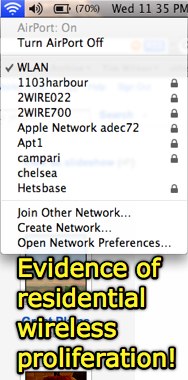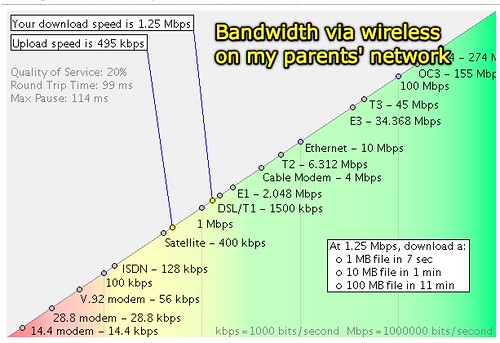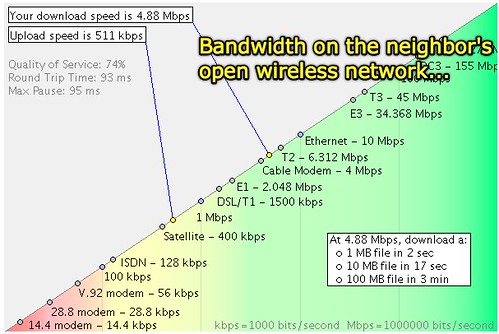Clearly parts of the world are changing dramatically with respect to high speed Internet access. Our family is spending the Thanksgiving holidays with my parents in Kansas. Several years ago, there was only one other wireless network “visible” from my parents’ house. Last time I was here a few months ago, I seem to recall there were three or four. Now, in November 2007, there are NINE:
There may be more with hidden SSIDs, but eight other networks besides my parents’ are visible. A quick visit to the free Internet Frog Speed Test website reveals the downstream bandwidth on my parents’ high speed connection is ok, but not really zippy. This has to do, in part, with the fact that they have basic WEP encryption turned on for their network. The SSID is also hidden from casual users. A hidden SSID doesn’t affect access speeds, but may prevent folks you don’t know from just “wandering on” to your wireless network. This is the graph of my parents’ network bandwidth downstream and upstream:
Of the 9 available wireless networks in our immediate area, only ONE is not secured with a password. That network has wifi downstream bandwidth approximately four times faster than my parents:
This is interesting as well as practically useful information.
John Horrigan, in the October 18, 2007 report “Broadband: What’s All the Fuss About?” for the Pew Internet & American Life Project,” cites another report from Pew in July 2007 (“Home Broadband Adoption”) indicating almost half (47%) of all adult Americans have a broadband connection at home as of early 2007. So what is everyone doing with these high speed Internet connections? Well, certainly people are still reading and sending a lot of email and reading a lot of webpages, but Horrigan writes that a growing number of people are both writing and reading blogs. He noted in July:
Only about 8% of U.S. internet users have their own blogs, but 39% read someone else’s blog. And while no more than one in 10 blogs is about politics, 20% of those who get political news online have read political blogs. And while only a small minority of online users either create or forward online videos with political content, 15% of all internet users have watched a political video online, while 37% have watched a news video of any kind online.
Certainly peer-to-peer file sharing and watching online videos on sites like YouTube feature prominently in the high-bandwidth consuming activities of some, but the CREATION of content in various forms does as well. Horrigan also wrote in October:
The fuss about broadband, then, extends beyond access to information to active participation in the online commons as people with shared interests or problems gather at various online forums to chat or collaborate.
As Quyen Arana challenged educators this past August in his luncheon keynote at the Oklahoma state librarian’s conference, PARTICIPATION with media is of key importance to both understanding the ways students are using and want to use digital technologies — as well as the learning process itself.
Are my parents’ neighbors blogging and creating multiple forms of content on the web? The only way to find out is to ask them! If the trends identified in these Pew reports hold true, an increasing number of them ARE contributing content to the read/write web. It’s certainly clear there are more wireless network signals crisscrossing the neighborhood than ever before!
Technorati Tags:
broadband, wifi, bandwidth, education, school
If you enjoyed this post and found it useful, subscribe to Wes’ free newsletter. Check out Wes’ video tutorial library, “Playing with Media.” Information about more ways to learn with Dr. Wesley Fryer are available on wesfryer.com/after.
On this day..
- Using the Daum Equation Editor to Format Math Equations for Wolfram Alpha – 2012
- Google Tools Workshops in Oklahoma City: 14-15 December 2010 (flyer) – 2010
- How to publish an audio lecturecast with Podcast Generator (screencast demo) – 2010
- Meet Jonney Shih, Netbook innovator – 2009
- Power of Google Voice Transcriptions comes to YouTube with Automatic Annotations – 2009
- GPS learning in the air and on the highway – 2008
- 1963 to 2007: Broadcasting has come a long way – 2007
- Oklahoma centennial photos, videos, and reflections – 2007
- Create a skype button – responsibly – 2007
- 3rd grade website about Africa – 2006



